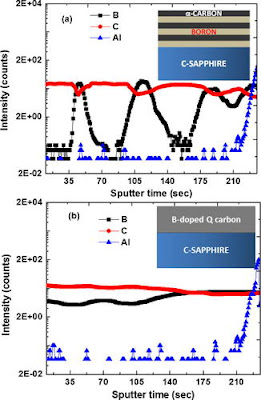ABSTRACT
Following a brief report on high-temperature superconductivity in B-doped Q-carbon [Bhaumik et al., ACS Nano 11(6), 5351–5357 (2017)], we present detailed structure-property correlations to understand the origin of superconductivity in strongly bonded lightweight materials and methods to further enhance the superconducting transition temperature (Tc). Nanosecond melting of carbon in a super undercooled state and rapid quenching result in a strongly bonded unique phase of B-doped Q-carbon. The temperature-dependent resistivity and magnetic susceptibility measurements demonstrate type II superconductivity in this material with a transition temperature of 36.0 ± 0.5 K and an upper critical field of 5.4 T at ∼0 K. It has also been shown that in B-doped Q-carbon, the upper critical magnetic field (Hc2(T)) follows Hc2(0) [1-(T/Tc)2.1] temperature dependence and is consistent with the Bardeen–Cooper–Schrieffer formalism. In the present study, B-doped Q-carbon thin films are formed on sapphire substrates by employing pulsed laser annealing (PLA) using a nanosecond excimer laser. This process involves the rapid quenching of highly undercooled melt of homogenously mixed B and C. Through the structure-property correlation measurements in B-doped Q-carbon, we estimate a higher electronic density of states near the Fermi level. Higher density of states near the Fermi-level along with higher Debye temperature and phonon frequency are responsible for the enhanced Tc. As a result of rapid melting and quenching, we can achieve 17.0 ± 1.0 or higher atomic % of B in the electrically active sites of Q-carbon which leads to the formation of shallow electronic states near the valence band maximum. From the critical current density versus field moments, the value of critical current density (Jc (2T)) in B-doped Q-carbon at 21 K is calculated as 4.3 × 107 A cm−2, which indicates that this novel material can be used for the persistent mode of operation in MRI and nuclear magnetic resonance applications. This discovery of high-temperature superconductivity in B-doped amorphous Q-carbon shows that the non-equilibrium synthesis technique using the super undercooling process can be used to fabricate materials with greatly enhanced physical properties.
A novel high-temperature carbon-based superconductor: B-doped Q-carbonAnagh Bhaumik1, Ritesh Sachan1,2, and Jagdish Narayan1,a)Journal of Applied Physics 122, 045301 (2017); doi: http://dx.doi.org/10.1063/1.4994787

Comments